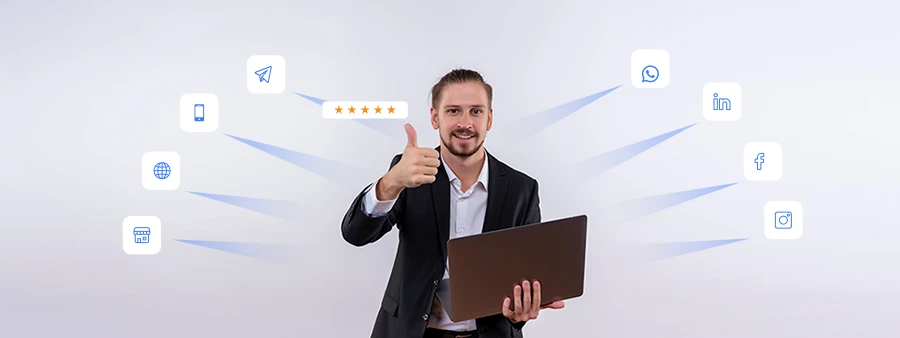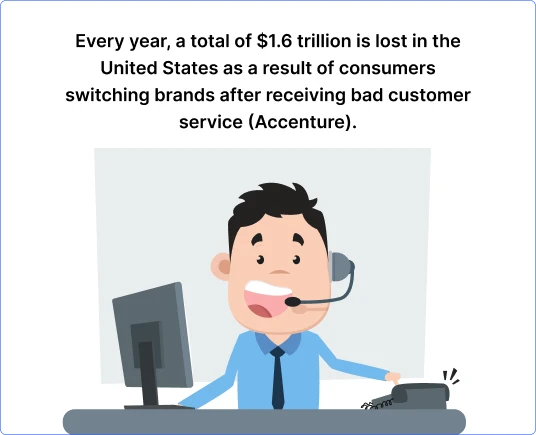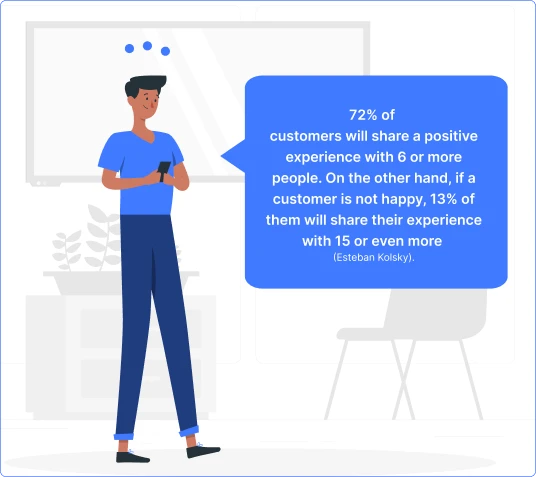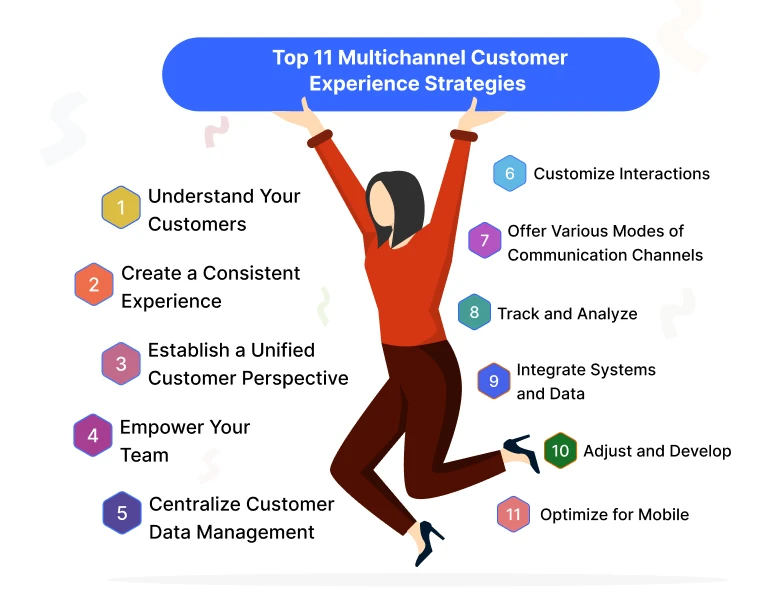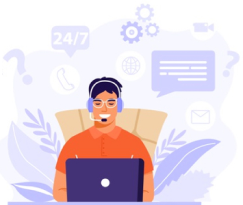In today’s digital world, customers don’t just stick to one place to find what they need. They jump between different platforms like social media and apps to explore products and services. So, businesses need to be where their customers are.
Imagine this: You’re scrolling through your favorite social media platform and see an interesting ad. You click on it and find yourself on a cool website where you can learn more about the product. You are impressed. Next, you decide to download the brand’s app to make a purchase. Everything feels smooth and easy like the whole experience was made just for you.
This is what multichannel customer experience is all about—making sure businesses are ready to meet customers wherever they go, with a personalized journey.
Seems interesting? In this article, we will talk more about the concept, why it’s important, the best strategies, tips, and challenges.
What is a Multichannel Customer Experience?
A multichannel customer experience refers to the practice of providing customers with various ways to interact with a business on different channels such as websites, physical stores, mobile apps, social media, and more.
Here your customers have the option to contact your brand through different channels according to their preferences and convenience.
Benefits of Multichannel Customer Experience
A recent study, jointly conducted by Gartner and Forbes, revealed that 55% of participants experience an emotional bond with a company when they have the option to contact customer support through various channels.
Here are more advantages to look into:
You Are Accessible
How are you with your near and dear ones? Must be always reachable. They can call you, message you, and even chat with you over video calls. Why? Because they are part of your family. Your customers will also feel the same if you are always reachable to them whenever they need assistance. Multichannel marketing makes it possible.
Meet Your Customers Where They Are
Some customers might start chatting on one app but switch to another later. Others like sticking to what they know and prefer one way to reach out. And some pick a method depending on how fast they want a reply and how tricky their issue is.
To help your customers, it’s important to understand how they want to engage with you and make it easy for them. Multichannel customer service means you’re there to help on all the platforms they like best.
Increased Customer Satisfaction
By offering assistance on each of their preferred channels, you are walking the extra mile to make them happy and satisfied. You are in a way providing them the assurance that your brand is always available for them whenever they need you.
More Loyal Customers
The happier your clients are, the more they are to buy from you. Opting for a multichannel customer experience makes it possible. Your loyal customers will also spread the word about your brand, becoming your ambassadors and recommending it to others.
Helps to Offer Personalized Services
Leveraging data from various channels allows you to create more personalized experiences for your customers. By understanding their behavioral patterns and preferences across various touchpoints, you can tailor your interactions and offerings to better meet their needs.
Improved Brand Visibility
Being available on multiple channels increases your brand’s visibility and reach. It allows you to engage with customers wherever they are, whether it’s on social media platforms, websites, mobile apps, or physical shops. This broader presence helps to strengthen brand awareness and can get you some new customers.
How to Offer Multichannel Customer Experience: 11 Best Strategies
Implementing a successful multichannel customer experience strategy requires careful planning and execution. Here are the 11 basic steps to follow for offering a seamless multichannel experience:
1. Understand Your Customers
First, understand who your target audience are and what they want from you. Try to find out their preferences, pain points, requirements, and most preferred channels of communication like live chat, email, phone, or social media platforms. Run regular surveys, gather data, and analyze customer interactions to understand them in a better way.
2. Create a Consistent Experience
Be consistent in all your communication. You should maintain this in branding, messaging, and customer service across all channels. Ensure that customers receive the same level of experience whether they interact with your brand through your website, mobile app, social media, or in person.
3. Establish a Unified Customer Perspective
Set up a customer relationship management (CRM) system that gathers all customer data from different communication platforms and puts it in one central spot. This makes it easier for your team to see customer interactions and their behavioral patterns across all channels. It will help them to understand each customer journey in a better way for further improvements.
4. Empower Your Team
Support your customer service team to serve other customers in a better way. Equip them with the latest tools, training, and authority they need to deliver excellent multichannel support. Ensure they have access to unified customer data, omnichannel communication tools, and hands-on training on handling multiple inquiries across different channels effectively.
5. Centralize Customer Data Management
Let your customers easily switch between different communication channels during their interactions with your brand. For example, allow them to start a conversation on social media and seamlessly continue it via email or live chat without having to repeat the same information.
Meanwhile, add a centralized data management system from where you can handle all the interactions and keep track of everything.
6. Customize Interactions
Incorporate personalization into your multichannel customer engagement strategy. You should personalize each interaction for individual customers based on their preferences, behaviors, and past interactions with your brand. Whether they’re engaging with you through social media, email, your website, or in person, make each interaction feel unique and relevant to them.
Customer Management Tools (CRM) help you to collect such data and manage everything from a central point. This personalized approach can enhance customer satisfaction, loyalty, and overall engagement with your brand across all channels.
7. Offer Various Modes of Communication Channels
Let your customers choose their preferred communication channels to interact with your brand. This can include phone support, email, live chat, social media, mobile apps, and in-person assistance. Allow them to choose the channel that best suits their needs and preferences at any given time. This way, you make it easier for them to communicate with you in the way they prefer.
8. Track and Analyze
Keep an eye on how customers are interacting with you on different platforms and ask for their feedback regularly to see how well your strategies are working.
Get analytics on how quickly your support agents respond, how happy the customers are, how many people buy your products or services after talking to you, and how well each of your communication channels is performing. Use this information to find drawbacks for further improvements and make your approach to interacting with customers on different channels even better.
9. Integrate Systems and Data
Invest in technology that allows seamless integration of customer data and interactions across different channels. A unified customer relationship management (CRM) system or customer engagement solutions help you to centralize all customer information. Your team can efficiently deliver consistent and personalized experiences regardless of the channel.
10. Adjust and Develop
Keep an eye on the new trends and technologies coming up in your domain and always stay updated. Check on what new channels your customers are using to get in touch with your company, and their changing preferences, likes, and dislikes to update your plans accordingly. If there’s a new way people like to interact, think about if it would work for your customers as well, and if it does, add it to your plan.
Just remember, the most important thing is to make sure people get the same good experience no matter how they reach you. Making everything right, will get you happy customers even some new ones.
11. Optimize for Mobile
According to a report by Statista, there are 6.8 billion smartphone users globally. Another study from DataReportal indicates that 50.9% of digital shoppers use their mobile phones for shopping at least once a week.
Given the increasing use of mobile devices, ensure that all your digital channels are mobile-friendly and optimized for a seamless experience on smartphones and tablets. This includes responsive web design, mobile apps, and messaging platforms tailored for mobile users.
Key Challenges of Multichannel Communication
According to a research study conducted by Forrester, a majority of leaders, about 62%, consider self-service as the most important channel for customer service. However, despite the benefits, embracing a multi-channel communication system comes with its challenges.
From initial setup to ongoing maintenance, managing multiple channels can be complex and demanding for you. Additionally, determining the priority of each channel adds another layer of difficulty to the process.
Here are some of the challenges we need to discuss now!
Consistency
Well, now this is difficult. Maintaining consistency across all your communication platforms can be a tough task. To maintain consistency in all customer interactions, you must have effective planning and execution strategies in place for your brand message, tone, service quality, and other information.
How to deal with this? Here are some tips for you!
- Create comprehensive brand guidelines that outline your brand’s identity, values, voice, and tone.
- Provide training to employees on your brand guidelines and ensure that they understand the importance of consistency.
- Develop templates, scripts, and standardized responses for common customer inquiries and interactions.
- Implement centralized communication channels, such as a CRM system or helpdesk software, to manage customer interactions. This allows for better coordination and ensures that all team members have access to the same information.
- Routinely review and update content across all channels to ensure accuracy and relevance.
- Use performance metrics and customer feedback to monitor consistency across channels.
Integration
Integrating multiple channels seamlessly is a significant challenge. Often, different channels operate in silos, leading to fragmented customer experiences. To achieve smooth integration, you need robust technology infrastructure and coordination between departments.
Pro Tips:
- Start by defining clear objectives for integration, such as improving data accessibility, streamlining processes, or enhancing customer experience.
- implement a centralized CRM system, or customer engagement software for seamless data exchange between different communication platforms.
- Conduct a thorough assessment of your existing systems and processes to identify integration points and potential bottlenecks.
- Test integrations thoroughly to ensure they work as per your plans and meet business requirements.
- Continuously monitor the performance of integrated systems and processes to identify areas for improvement.
Data Management
When you offer multichannel customer service, no doubt you will get a vast amount of data from various sources. Managing this data effectively, ensuring its accuracy, and leveraging it to enhance the customer experience can be a tough job. So you need data integration and analytics solutions in place to manage everything from a central point.
Pro Tips:
- Establish clear data management policies and procedures that show how data is collected, stored, processed, and shared across different channels.
- Consolidate customer data from various channels into a centralized repository, such as a customer relationship management (CRM) system or a data warehouse.
- Implement data quality controls and validation checks to identify and correct errors, duplicates, and inconsistencies in data.
- Invest in data management tools and technologies, such as data integration platforms, master data management (MDM) systems, and data quality solutions, to automate and streamline data management processes.
Mapping the Customer Journey
Understanding the customer journey across all the channels can be complex for you. Customers may switch between various channels during their interaction with your brand, and for mapping these journeys accurately you need to have a deep understanding of customer behavior and preferences.
Pro Tips:
- Run thorough research to understand your customers’ needs, preferences, and pain points.
- Identify all the touchpoints where customers interact with your brand across different channels, including online and offline.
- Create visual maps or diagrams that illustrate the customer journey from initial awareness to post-purchase support.
- Segment your customer base into different personas based on demographics, behavior, and preferences. Create separate customer journey maps for each persona.
- Identify pain points, bottlenecks, and areas of friction in the customer journey where customers may encounter obstacles or have negative experiences.
- Opt for data and analytics tools to track customer interactions, behaviors, and preferences across channels.
Resource Allocation
Allocating your resources effectively across multiple channels can be tricky. Different channels may require different levels of investment in terms of technology, staffing, and marketing efforts. So, to maximize ROI while maintaining a consistent customer experience you need to smartly prioritize the resources.
Pro Tips:
- Define clear objectives and key performance indicators (KPIs) for your multichannel customer experience initiatives.
- Assess the return on investment (ROI) of each channel by evaluating factors such as customer acquisition costs, conversion rates, and lifetime value.
- Segment your audience based on demographics, behavior, and preferences to identify which channels are most effective for reaching different customer segments.
- Continuously monitor and optimize resource allocation based on performance data, customer feedback, and changing market conditions.
- Invest in automation tools that can streamline processes, reduce manual effort, and free up resources for more complex tasks.
Technical Complexities
Multichannel customer experience often involves dealing with various technologies, platforms, and APIs. Ensuring compatibility and addressing technical issues promptly is very important to provide a seamless experience for customers.
Pro Tips:
- Conduct a thorough assessment of your existing technical infrastructure, including software, hardware, and networking components.
- Design your technical architecture with scalability in mind to accommodate future growth and changes as per customer demands.
- Implement automation tools to streamline repetitive tasks.
- Establish monitoring mechanisms to track the performance, availability, and reliability of your multichannel systems in real time.
Security
Managing security and compliance across multiple channels is important but complicated, especially when dealing with sensitive customer information. Ensuring that data is protected and that all interactions comply with relevant regulations adds another layer of complexity.
Pro Tips:
- Conduct regular security audits and vulnerability assessments to identify and mitigate potential security risks and weaknesses in your multichannel systems.
- Always stay up-to-date with relevant regulation requirements.
- Secure APIs and integrations between different systems and channels to prevent unauthorized access and data leaks.
- Arrange regular training sessions to educate your employees about security best practices.
Offer Excellent Multichannel Customer Experience with REVE Chat
Want to be where your customers are? REVE Chat makes it possible for you. It’s one of the best multichannel customer engagement platforms that lets you offer instant assistance on websites, mobile apps, and other social media platforms like Facebook, Viber, Instagram, Telegram, and WhatsApp.
The best part is that with REVE Chat you can automate customer engagement on their preferred platforms and manage all the interactions from a single touch point. REVE Chat also offers an AI-powered chatbot to automate all your business operations including customer service 24/7 even after your business hours.
Ready to give it a shot? SIGN UP for its 14-day FREE TRIAL today.
;)
